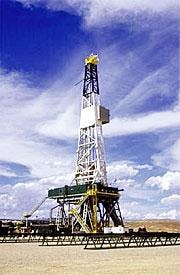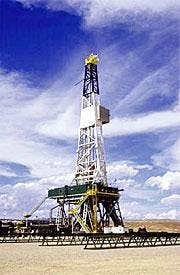With US land drilling activity up 32% from year-ago levels through May, both the demand for rigs and the resulting day rates are expected to continue to increase through the rest of 2003 and into 2004, analysts at Jefferies & Co. Inc.'s Houston office reported.
"We believe that operators will grow more confident about natural gas fundamentals during 2003, as natural gas prices remain above $5/Mcf and producers struggle to refill low storage levels due to declining US and Canadian production, firm industrial demand, and higher exports to Mexico," said Jefferies analyst S. Magnus Fyhr.
Anadarko Petroleum Corp., Houston, the most active exploration and production company onshore US, increased its 2003 drilling budget by $200 million. "We believe that increased budget allocations will further stimulate North American onshore drilling activity as well as improve demand in the Gulf of Mexico jack up market, which has had a small but steady increase in demand over the last few weeks," Fyhr said.
Both large and small independent producers are likely to "reinvest higher-than-expected cash flow back into the drillbit," said Fyhr. "Although some large independents like Anadarko, Burlington [Resources Inc., Houston], EOG [Resources Inc., Houston], and Devon [Energy Corp., Oklahoma City] have stepped up their onshore drilling activity [in the second quarter], a large portion of the increase in land drilling activity has come from smaller independents and privately owned E&P companies.
"In fact, the market share for the 15 largest onshore rig [clients] has declined from approximately 35% in February to 32% currently as smaller operators have recently been more aggressive in contracting rigs," he said.
With the surge in drilling activity, several contractors raised day rates for land rigs by "$300-500, as well as pass-through increases in labor costs." With "more available land rig capacity compared to the previous two cycles," however, "we expect day rates to increase modestly for the remainder of the year, with more significant increases in 2004 as rig availability is expected to decline," said Fyhr.
Jefferies' revised projection of onshore rig activity "may prove to be conservative," at an average of 915 rigs working in the third quarter of this year, 980 in the fourth quarter, 1,016 in 2004.
Gulf operations
With more rigs leaving the Gulf of Mexico this summer, day rates for jack ups in those waters are expected to increase in the last half of this year, said Fyhr.
"Several contractors are reporting an increase in bid activity and are also receiving 60-90-day commitments and developing a small backlog for some rigs," he said. "The domestic jack up market is also beginning to benefit from an increase in day rates, as some rigs have recently been contracted at day rates approximately $2,000-4,000 higher than previous contracts."
Fyhr said, "Day rates could potentially accelerate above our current forecast as rig availability could become very limited" by the fourth quarter of this year.
Recent deep gas discoveries in relatively shallow waters on the gulf's outer continental shelf are fueling demand for jack up rigs. "Newfield [Exploration Co., Houston], El Paso [Production Co., Houston], and Unocal [Corp.] have several deep gas prospects to drill this year," Fyhr said.
"We believe that the recent deep gas trend could also help improve domestic jack up utilization, as deep gas wells typically take up to 90-120 days [to drill], compared with 30 days for a typical Gulf of Mexico well."
null
He said, "We believe that the [2003] Central Gulf of Mexico lease sale provides further evidence of increasing interest in the US gulf and deep gas, as the sale drew the highest number of bids for a Central Gulf sale since 1998, with two thirds of those blocks in shallow water" (OGJ Online, Mar. 19, 2003).
The deep gas play in the gulf is estimated to hold 10.5 tcf of recoverable natural gas 15,000 ft below the ocean bed.
First quarter activity
US rig activity in the first quarter of this year increased by 6.3% from year-ago levels to an average 899 rigs working during that period, said Patrick McGeever, Fitch Ratings Ltd., in another May report. The average number of rigs drilling for oil increased by 8% during that period, while gas drilling was up 6%, he said.
Canada's average rig count jumped to 493 in the first quarter, a whopping increase of 29% from the first quarter of 2002, McGeever reported. "This large increase suggests that operators are now focusing on drilling to provide natural gas used in oil sands projects and to replenish below-average [US gas] storage," he said.
"The remainder of 2003 should be bullish for the [US] rig count, particularly the natural gas rig count, due to gas prices that remain at more than $5/Mcf and inventories that linger below the 5-year average."
The international rig count registered a 10% annul increase with an average 1,240 rigs working in first quarter 2003, said McGeever. "Most of the increase was due to the large improvement in Canada," he said.
Drilling activity was up 10% in the Middle East, however, and 8% in the Far East, he said. Drilling activity was down 13% in Europe, 4% in Latin America, and 2% in Africa. "Given where commodity prices are, activity internationally should be stronger throughout the year," he said.
Service sector stable
"The oil services sector has been reasonably stable due to rising rig counts, offset by pockets of weakness, particularly in the Gulf of Mexico, the North Sea, and Venezuela," McGeever said.
Market conditions should strengthen, he said, "as Venezuelan production ramps up, independents enter the North Sea, and the effect of the expanded royalty relief in the shallow waters of the Gulf of Mexico begins to take hold. For the most part, service companies continue to focus on improving their technology, cost structures, and capital discipline."


